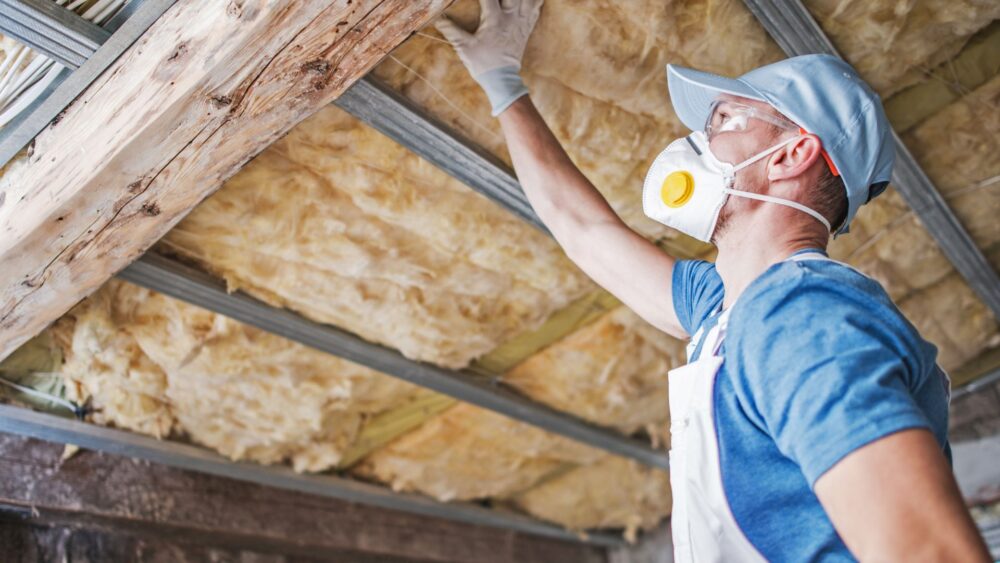So, you’re thinking about taking on the challenge of improving your home’s insulation. So, this isn’t just another task to check off your list; it’s a total game-changer that ramps up your comfort while dialing down those energy bills. With countless homeowners feeling the pinch of rising energy prices, turning your attention to home insulation isn’t just smart—it’s essential. But where do you start? So, let’s dive a bit deeper – what are the real perks of giving those walls and attics an upgrade? Let’s peel back the layers (pun intended) and explore how making your house snug as a bug with top-notch insulation is less about battling weather extremes and more about reclaiming control over your indoor climate.
Types of Home Insulation
When it comes to insulating your home, you’ve got options. Lots of them.
Blanket Batts and Rolls, Blown-In Insulation, Spray Foam Insulation, Foam Board Insulation, Radiant Barrier Insulation
Blown-in insulation is a popular choice, especially for those hard-to-reach spaces like attics. The most common materials used for this type are cellulose, fiberglass, and mineral wool. Spray foam insulation is another top pick. It’s made from polyurethane and can fill even the tiniest cracks and crevices. Foam board insulation is great for exterior walls and foundation walls. It’s made from polystyrene or polyisocyanurate and comes in insulated panels. And let’s not forget about good old batt insulation and roll insulation. These tried-and-true options are usually made from fiberglass, rock wool, or mineral wool.
Insulation Materials Explained
So what exactly are these insulation materials made of? Let’s break it down.
Fiberglass, Cellulose, Rockwool, Cotton, Polystyrene, Polyisocyanurate
Fiberglass is the most common insulation material. It’s made from fine glass fibers and is often used for attic insulation and wall insulation. Cellulose is made from recycled paper products and is often used for blown-in insulation in attics and crawl spaces. Rockwool, also known as mineral wool, is made from basalt or slag and is great for soundproofing. Cotton insulation is made from recycled denim and is often used for basement insulation and insulating rim joists. Polystyrene and polyisocyanurate are types of foam insulation often used for insulated panels and spray foam. The key is choosing the right insulation options for your specific needs and budget. Don’t be afraid to mix and match.
Factors Affecting Home Insulation Costs
So you’re ready to insulate your home. But how much is it going to cost you?
Location, Material, Labor, New vs. Existing Construction, Removing and Replacing Existing Insulation
The cost of insulation varies widely depending on a number of factors. Where you live plays a big role – prices per square foot can vary significantly from region to region. The type of insulation material you choose also impacts the price. Some options, like spray foam insulation, have a higher price tag but also offer superior energy efficiency. Labor costs are another consideration, especially if you’re insulating an existing home. Accessing hard-to-reach areas like attic spaces or working around wall studs and basement walls can be time-consuming. Speaking of existing homes, removing and replacing old insulation will add to the total square footage and cost. You may need to add additional insulation to exterior walls, unfinished attics, and unfinished walls to get your home up to current energy standards. On the flip side, insulating a new construction home is often more straightforward and affordable, since you’re starting with a clean slate and can easily access large areas and framed spaces.
Benefits of Installing New Insulation
The upfront cost of insulating your home may seem daunting, but the long-term benefits are well worth the investment.
Energy Efficiency, Temperature Regulation, Sound Insulation, Moisture Control
First and foremost, proper insulation can dramatically improve your home’s energy efficiency. By preventing air leaks and helping to maintain a consistent temperature, you can significantly reduce your heating and cooling costs. Insulation also helps to regulate the temperature throughout your home, eliminating cold spots and keeping your living spaces comfortable year-round. Say goodbye to that one room that’s always freezing in the winter. Sound insulation is another major perk. Insulation works wonders by soaking up all that noise and those pesky vibrations, giving you a home that’s not just quiet but downright serene. This is especially important if you live in a busy urban area or have noisy neighbors. Finally, insulation can help to control moisture and prevent dampness in your home. This not only improves indoor air quality but also helps to protect your home’s structural integrity. When choosing insulation, look for options with a high R-value, which measures the material’s resistance to heat flow. The higher the R-value, the better the insulation performance.
DIY vs. Professional Installation
So you’ve decided to take the plunge and insulate your home. But should you tackle the project yourself or hire a pro?
Pros and Cons of DIY Installation, When to Hire a Professional, Tools and Equipment Needed
DIY insulation installation can be a great way to save money, but it’s not for everyone. If you’re handy and have experience with home improvement projects, you may be able to handle simple tasks like installing batt insulation or roll insulation in easy-to-access areas. However, more complex projects like blown-in insulation or spray foam insulation often require specialized equipment and expertise. In these cases, it’s best to leave the job to a professional. Even if you’re going the DIY route, you’ll need to invest in some basic tools and safety gear. A good utility knife, measuring tape, and straight edge are essential for cutting insulation batts to size. You’ll also need protective gloves, a dust mask, and safety glasses. For blown-in insulation, you’ll need to rent an insulation blowing machine. These can be tricky to operate, so make sure you get a thorough tutorial from the rental company. If you do decide to hire a professional, get quotes from several contractors and check their references and insurance coverage. A reputable installer will be able to assess your home’s specific needs and recommend the best insulation options for your budget and climate. Don’t forget, nailing the installation process is crucial if you want to squeeze every bit of value out of your insulation. Whether you do it yourself or hire a pro, take the time to do it right and enjoy a more comfortable, energy-efficient home for years to come.
FAQs in Relation to Home Insulation
What is the most effective insulation for a house?
Spray foam leads the pack. It seals leaks and gaps inside existing walls without needing a teardown.
What is the best way to fully insulate a house?
Combining spray foam in walls with fiberglass batts in attics and basements nails it. This duo blocks air and controls temperature.
Is whole house insulation worth it?
Absolutely. It slashes energy bills, boosts comfort year-round, and ups your home’s value. Think of it as an investment.
What are the 3 types of insulation?
Fiberglass batts offer easy DIY installation; loose-fill tackles odd spaces well; spray foam expands for tight sealing action.
Conclusion
By now, we’ve taken quite the journey through the insulating maze that wraps around our homes like an unseen blanket. If there’s one thing clear as daylight, it’s that proper home insulation is no mere accessory in our dwellings—it’s an outright necessity. From transforming frosty mornings into warm welcomes to keeping those summer scorchers at bay without breaking a sweat or bank account—insulation proves its weight in gold.
The real takeaway here? Skimping on good quality home insulation is like throwing money out of a window that doesn’t even have decent curtains—pointless and avoidably costly in so many ways. So whether you’re tackling drafts head-on or simply yearning for peace from noisy neighbors—the answer lies within well-chosen batts, rolls or sprays that hug every corner of your sanctuary.
In wrapping up this enlightening excursion through fluffy fiberglass realms and beyond—we see clearly now; investing time (and yes, funds) into properly insulating our castles is akin to setting down sturdy foundations for not only physical comfort but financial prudence too. The path towards enhanced living spaces threaded with coziness at every turn starts here—with savvy choices rooted deeply in understanding just how profoundly impactful great home insulation truly can be.




